This easy authentic Pad Thai recipe is incredibly quick to prepare and has a perfect balance of sweet, salty and sour flavors. Ready from start to finish in 30 minutes or less!
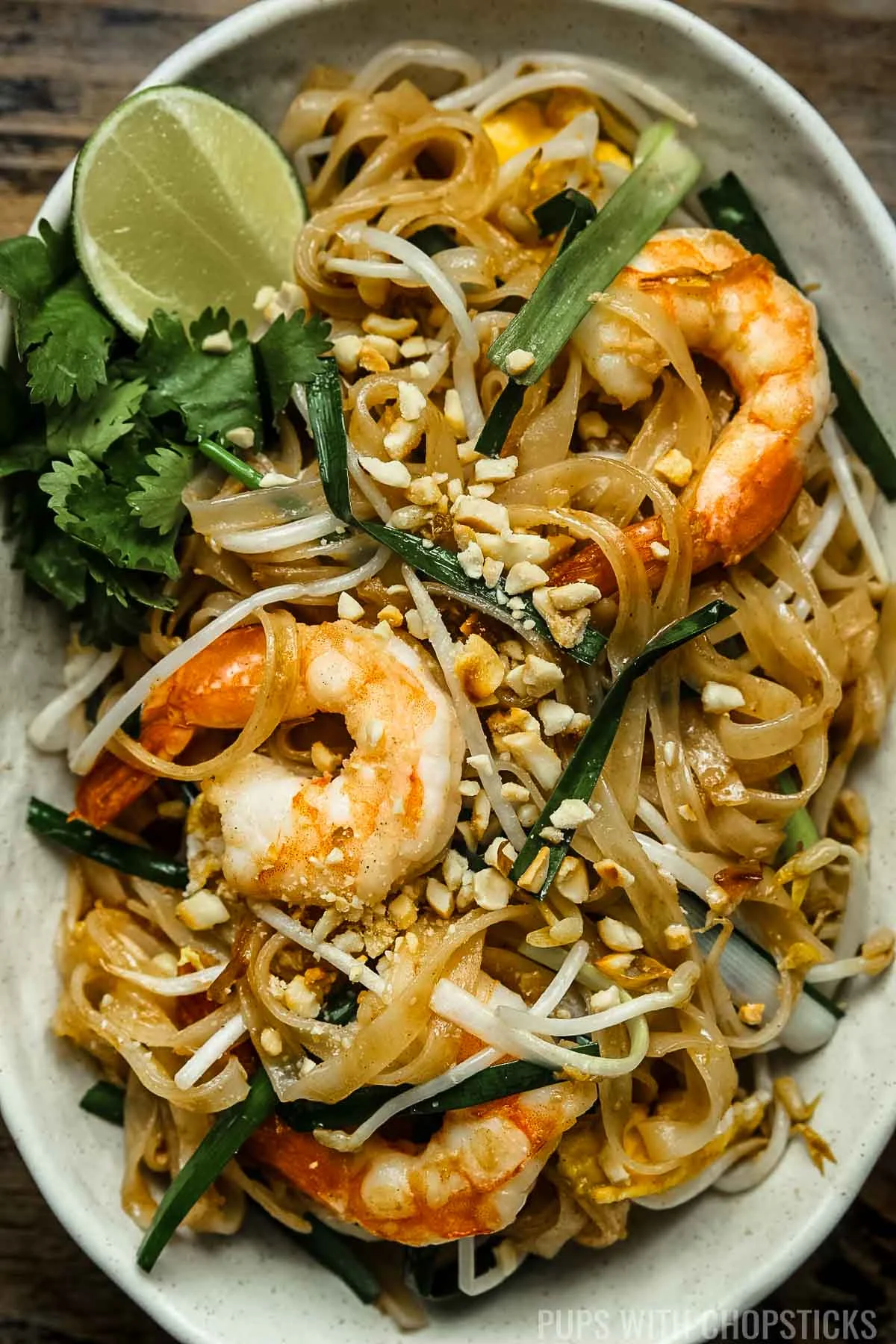
Table of Contents
- What is Pad Thai and How Does It Taste?
- Authentic Pad Thai Ingredients
- Joyce's Tips for the Best Pad Thai
- What Kind of Noodles to Use
- What is Pad Thai Sauce Made Of?
- How to Make Pad Thai
- How to Serve Pad Thai
- How to Store and Re-heat Pad Thai
- Frequently Asked Questions
- Recipes To Use Leftover Tamarind
- More Thai Recipes You May Like
- Did You Make This Pad Thai Recipe?
- Recipe Card
What is Pad Thai and How Does It Taste?
Pad Thai is a popular stir-fried noodle dish from Southeast Asia that originates from Thailand. The term "Pad" refers to the stir frying method and means 'fried', while "Thai" simply means Thai!
This delicious Thai dish is made of stir-fried rice noodles, eggs tossed in a perfectly balanced sweet, sour and savory sauce.
Although it may seem like an intimidating recipe because of all the complex flavors, this authentic Thai dish is quite easy to make and works best if you make it in small batches.
The key is getting the noodles just right to keep that chewy noodle texture with the delicious sweet, sour and salty flavors is by using a flavorful pad thai sauce and making sure you have the right ratio of noodles to sauce while you are stir-frying it.
Despite what we see in Thai restaurants in North America, in Thailand, authentic pad thai is never red, and never uses ketchup, it uses tamarind paste instead to give this noodle dish its unique sourness.
Authentic Pad Thai Ingredients
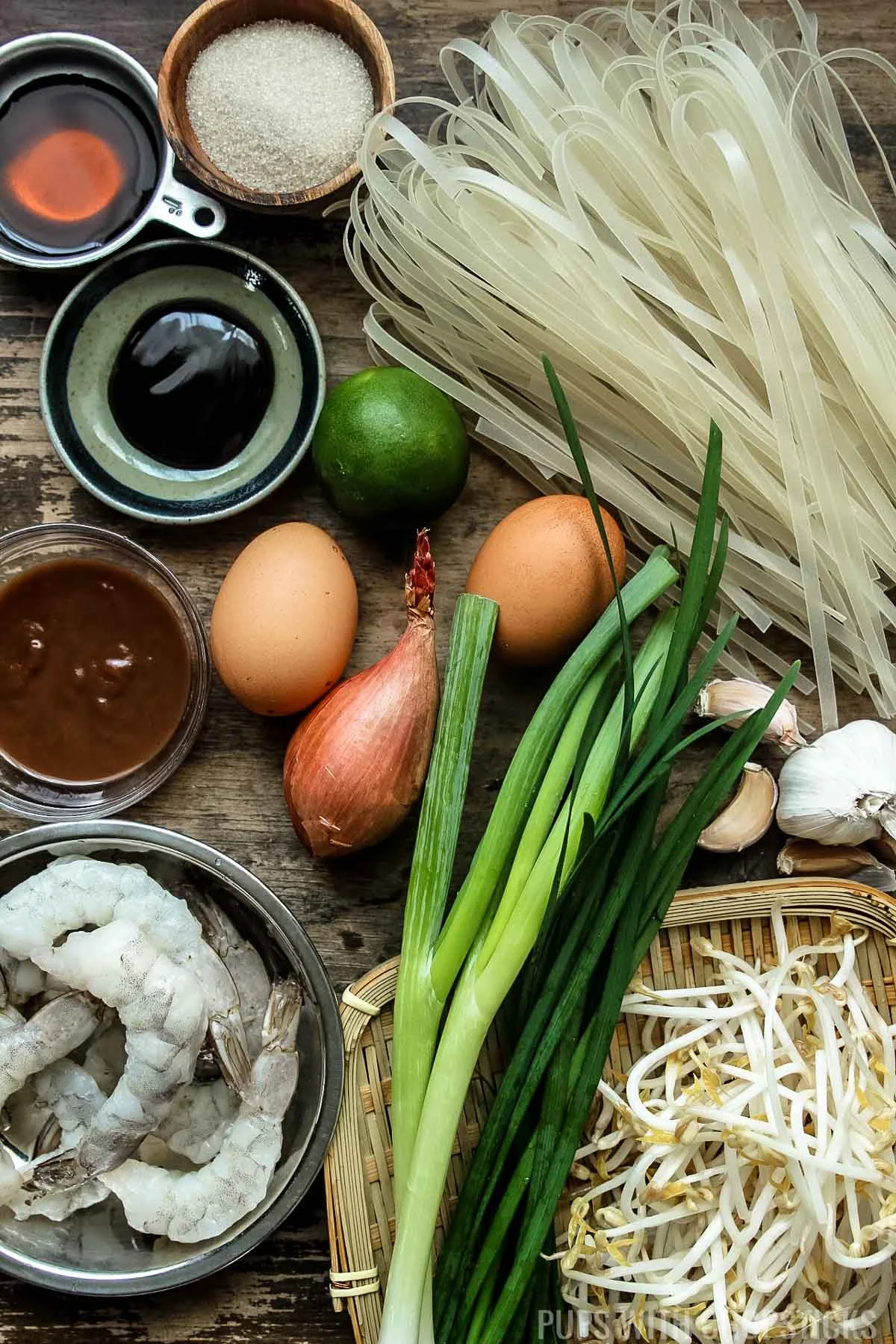
To make this pad thai recipe, you'll need a few key ingredients.
- Dried Flat Rice Noodles: You can find these in the Asian section of most grocery stores. I like to use medium-sized (¼ inch width) noodles. Make sure there is only rice in the ingredient list when you are shopping for it. They are also known as rice sticks.
- Chicken, Shrimp or Tofu: This is optional, but most pad thai recipes include some kind of protein. If you're using chicken, cut it into small, thin pieces. If you're using shrimp, make sure they're peeled and deveined (optional) and if you're using frozen shrimp make sure it has been thawed. If you're using tofu, use the firm tofu cut them into small, thin pieces.
- Egg: I use two large eggs for this pad thai recipe.
- Bean sprouts: This adds a nice refreshing crunch to the final pad thai dish.
- Scallions/Green Onions: This adds a mild onion flavor this Thai noodle dish and I highly recommend using it.
- Garlic Chives (Optional): If you can find garlic chives, it will also add some garlicky flavors to the pad thai. Treat them the same way you would use green onions.
- Peanuts (Optional): Crushed peanuts are a classic pad thai topping and add a great texture.
- Fish sauce: This is a key ingredient in pad thai and adds a salty, umami flavor. Look for it in the Asian section of your grocery store. I like to use Squid brand because its cheap, and only contains fish sauce and salt and no added preservatives.
- Sugar: You'll need a little bit of sugar to balance out the saltiness of the fish sauce. To keep things simple, I use cane sugar or light brown sugar, but you can use palm sugar if you have it.
- Tamarind Paste: To keep things simple, I like to use tamarind concentrate from the jars. They must be made in Thailand, the ones made from India are a lot more potent and concentrated and is not great for pad thai. That being said, in a pinch you can also use lime juice and it will turn out just as delicious. If you have tamarind pulp, you will need to prepare it by pre-soaking it boiling water before you can use it. I go into more detail about it below under 'Pad Thai Sauce'
- Lime: I like to use fresh lime wedges as a garnish and squeeze some fresh lime juice on top before I eat it to give it a bit more tanginess.
- Dried Shrimp and Pickled Radish (the sweet ones)(Optional): If you want to take your pad thai to another level, you can also add dried shrimp and pickled radish but they will add a lot more saltiness to it, so you should adjust your pad thai sauce and and use less fish sauce to make it less salty.
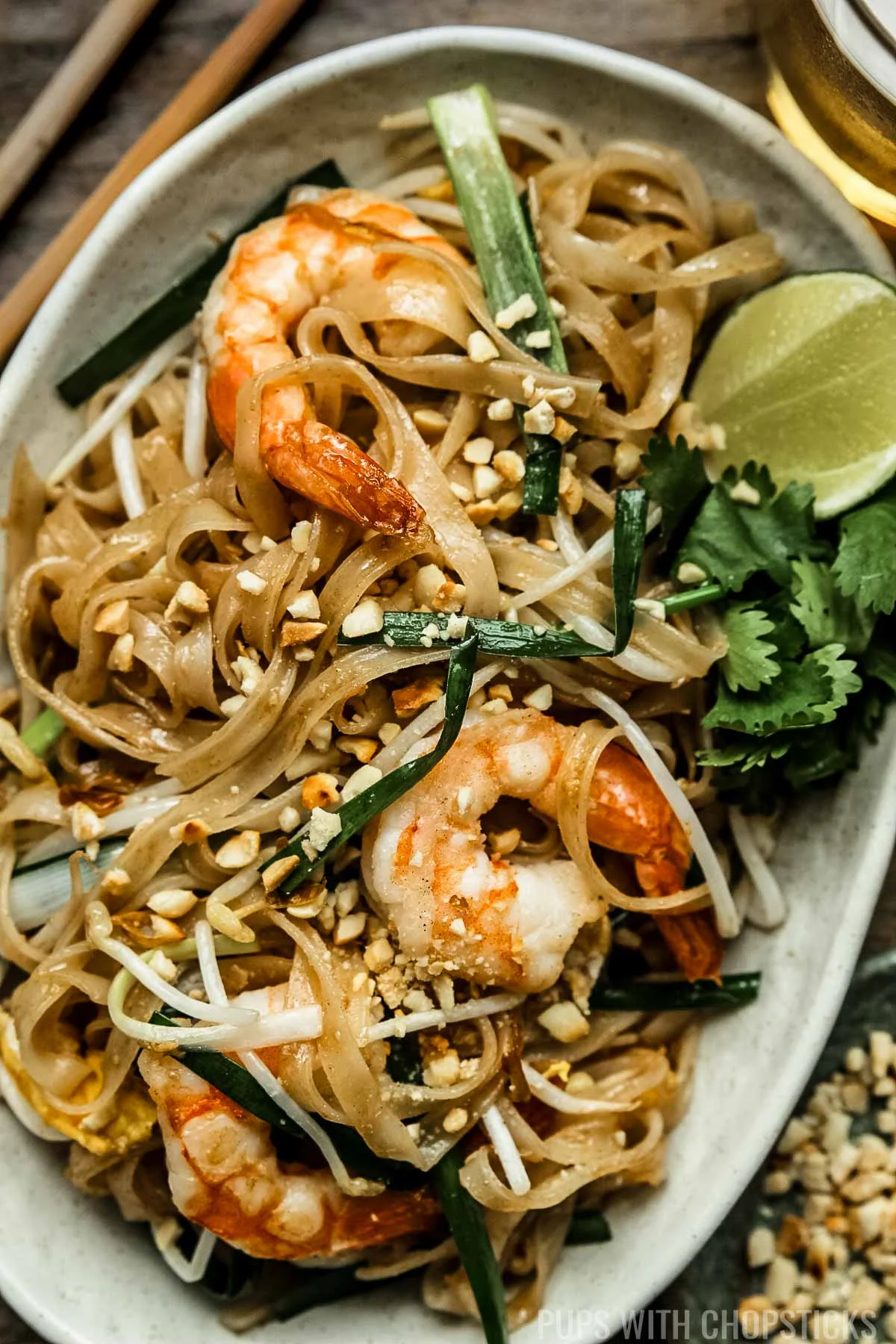
Joyce's Tips for the Best Pad Thai
- Prepare Everything Ahead of Time - Making pad thai is a very quick process, so having everything prepared ahead and within your reach will make this recipe incredibly easy to make.
- Don't Overcook Your Bean Sprouts - One of the best things about pad thai is that the textures and fresh bean sprouts give the dish a crisp texture and a fresh flavor. Bean sprouts can be easily overcooked (which can also make your noodles waterlogged). Turn off the heat before mixing the bean sprouts in, you only need the residual heat from the noodles to wilt it enough for the best texture.
- Don't Overcrowd Your Pan - When you overcrowd your pan, the sauce doesn't get distributed evenly, and the noodles don't cook evenly as well. You will also need space to push aside the noodles before you add the scrambled egg to the pan. Use a large frying pan, but if you have a small one, split everything in half and do it twice.
- Never Par-Boil Your Noodles - The best part about pad thai is the chewy, flavorful noodles. You never want to par-boil your noodles because it will make them mushy when you stir fry them because you are essentially cooking them twice. For the chewiest pad thai noodles, you only need to soak the rice noodle sticks.
- Don't Use Boiling Water to Soak Your Rice Noodles - Rice noodles are very quick to cook and delicate, and soaking them in boiling water will overcook it. I like to use hot tap water instead to insure they don't overcook while they are soaking. To test if the noodles are at the right consistency, do a finger wrap test after it has soaked for about 15 minutes. Wrap a noodle around your finger, if it breaks - you need to soak it longer, if it wraps easily it's good to go.
- Try to Use the Exact Measurement of Noodles and Sauce for the Best Flavor - For the best sauce to noodle ratio, it's very important not to use more noodles than this recipe calls for because it will throw off the balance of the amount of sauce the noodles need to absorb to get that strong delicious flavors. If there are more noodles than sauce, there won't be enough liquid for the noodles to absorb, which will make the noodles dry and flavorless.
What Kind of Noodles to Use
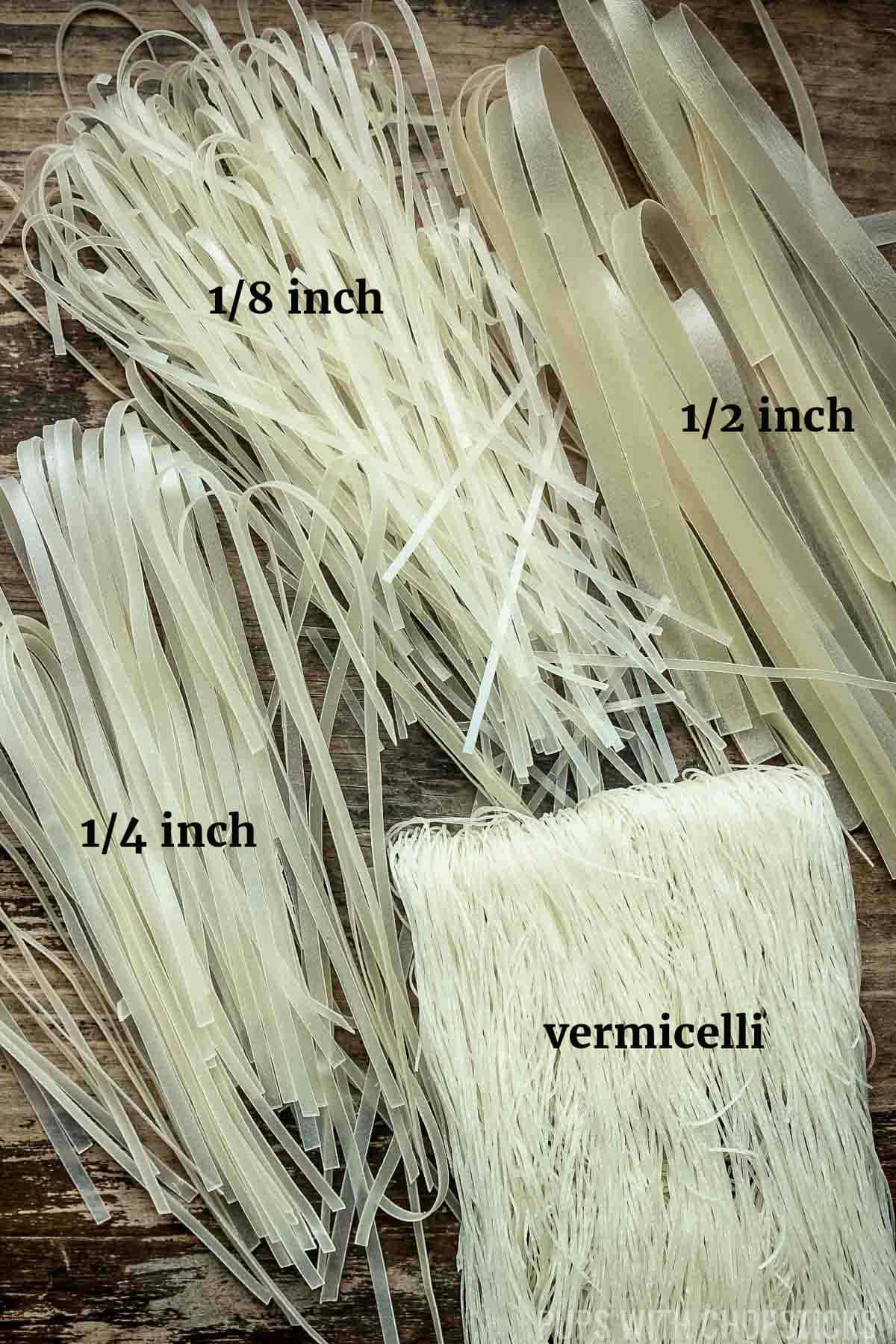
Pad thai is known for its chewy rice noodles but there are many different kinds of rice noodle out there, so how do you know if you're using the right kind?
When you're shopping for rice noodles for pad thai, you'll may notice that everything is called labelled as 'vermicelli' but they will all look different, which makes buying these rice noodles quite confusing.
To simplify it, here are two main things I always check for to ensure you are buying the correct rice noodles (vermicelli) for pad thai.
1.) Ingredient List
Make sure you read the ingredient list of the noodles it should only contain rice. There should be no wheat or any other starches in it.
2.) Noodle Size
This one is the tricky part, the width of the noodle.
Once you found the section with the rice noodles, you'll notice that there are many different sizes.
- ⅛ Inch - I don't recommend this size of rice noodles because they are too thin and will break easily when used in any type stir-fry. They are best used for soup noodles like Pho.
- ¼ Inch - The best width noodles for pad thai is the ¼ inch wide ones and is what we use at home.
- ½ Inch - This is too wide to for this pad thai recipe, but it will still work if you cannot find any other size. If you do go for a wider noodle, you may need to increase the sauce amount because it absorbs a lot more sauce. That being said, rice noodles with this type of width is best for dishes like Drunken Noodle (Pad Kee Mao) or Chinese Beef Chow Fun.
- Thin Vermicelli - thin vermicelli noodles are used for dishes like Singapore Noodles or Vermicelli bowls and are not the right size for pad thai.
What is Pad Thai Sauce Made Of?
Pad thai sauce consist of 3 flavors: salty, sweet and sour. To get the most delicious pad thai, you want to try to balance out the 3 flavors.
That being said, some will like it more sour and tangy (I highly recommend adding a wedge of lime on the side to allow people to tweak this) and some will like it more sweet or salty.
The Sour
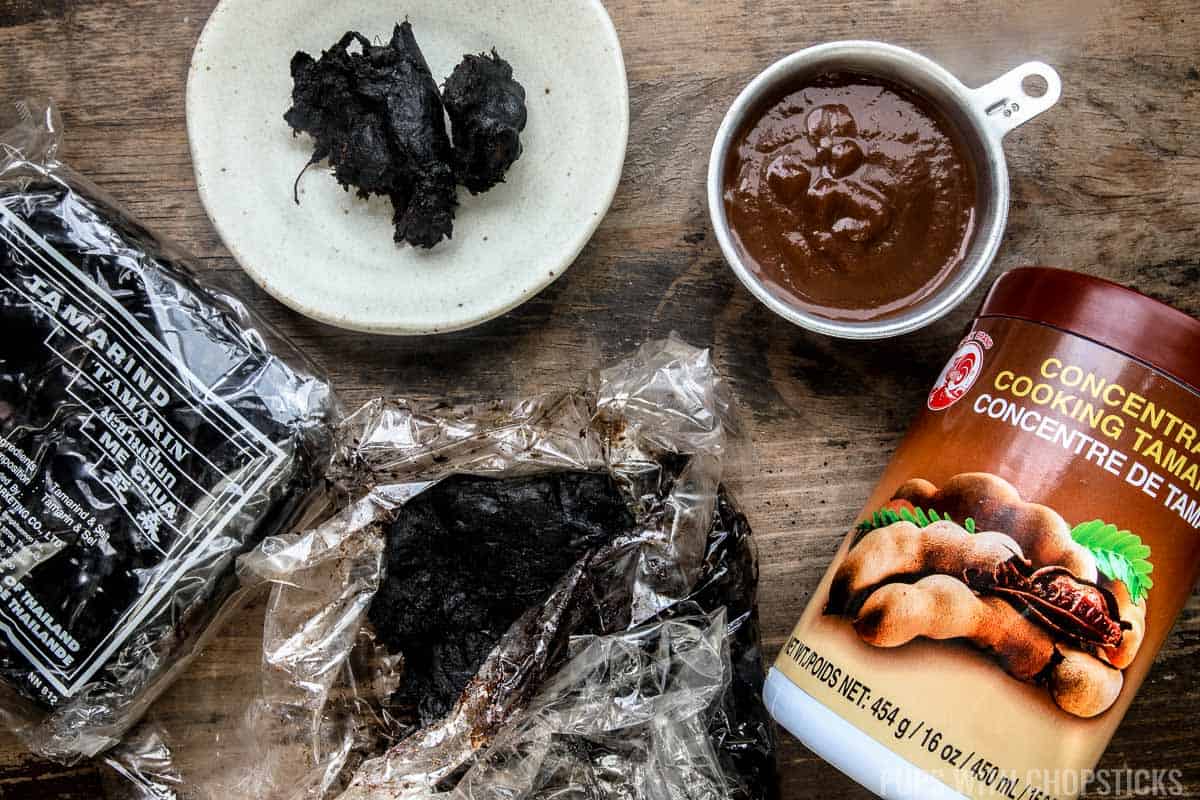
When it comes to giving pad thai that sour balance, there are a few ways to approach it. The authentic ingredient (and most delicious way) to give pad thai its tang is to use tamarind paste. It gives the noodle dish its sourness but also a bit of extra flavor as well.
There are 2 main types of tamarind paste on the market: tamarind pulp (which you need to soak in hot water, to remove the seed pods and skin, and tamarind concentrate.
When you are buying tamarind concentrate, you want to make sure it is made in Thailand because the one made in India is lot more stronger and concentrated and not good for Pad Thai.
If you can't find the jars of tamarind concentrate, you can make your own tamarind concentrate by soaking and mashing the tamarind pulp (which is a thick block of tamarind paste) in hot water and discarding the seed pods afterwards.
To learn more about how to prepare the tamarind pulp, you can reference my tamarind guide here, which goes into a lot more detail.
Alternatively, if you can't find tamarind concentrate, you can also use lime juice and will give you a similar fruity sourness like the tamarind concentrate.
Pad thai never uses ketchup and traditionally doesn't have a red color as well. The spice from the ketchup throws off the pad thai flavor, so I don't recommend it for making pad thai.
The Salty
To get the salty flavors, you will need to use fish sauce. I highly recommend not using soy sauce as a substitute because it can be a hit or miss and it has a strong soy flavor.
Alternatively, you can also added finely chopped dried shrimp or salted pickles for more salt as well.
The Sweet
For the sweet, I like to use what I have in the kitchen which is cane sugar, but you definitely can use white sugar or light brown sugar as well.
If you want to keep this recipe authentic, you can also use palm sugar but keep in mind that palm sugar is not as sweet, so you may need to add more. The closest substitute I have found to palm sugar is light brown sugar.
If you buy palm sugar in discs or blocks, you will need to break it up by either microwaving at 20 second intervals until it is soft enough to use, or pounding it with a mortar and pestle.
How to Make Pad Thai
Soak the Rice Noodles
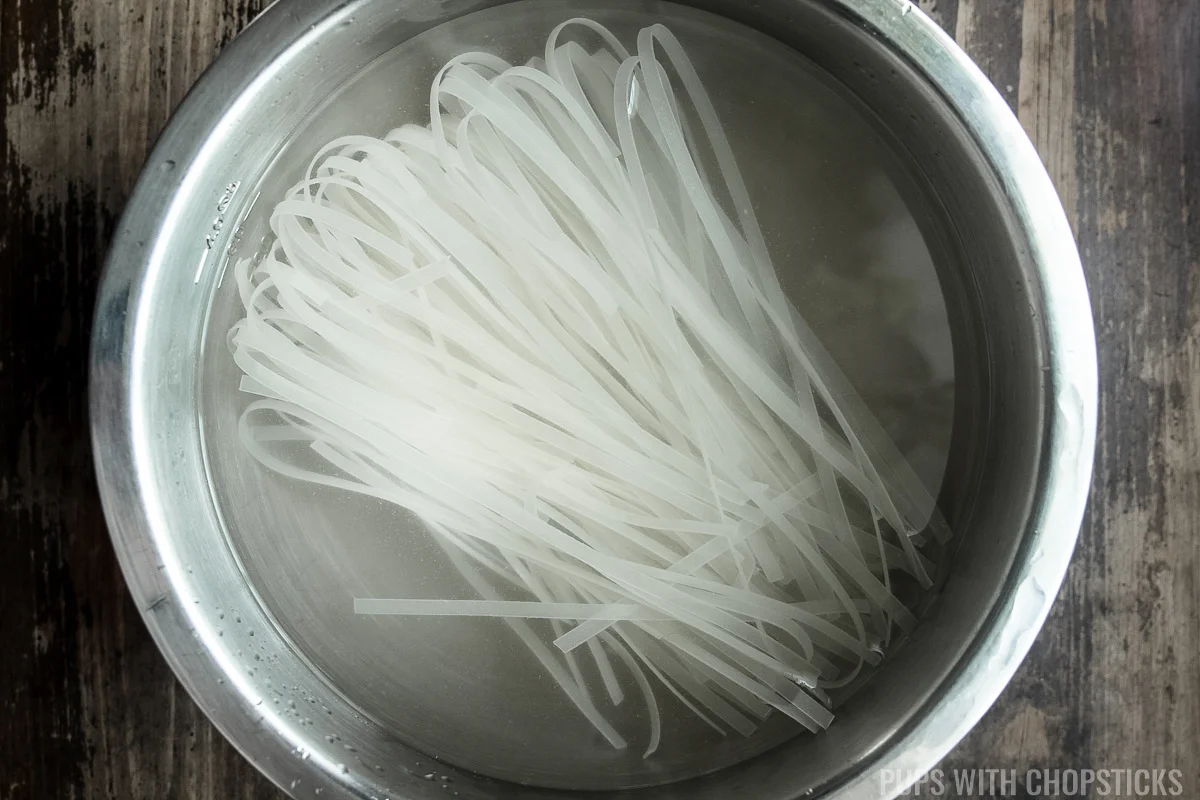
To master pad thai, you must begin with the dish's foundation: the rice noodles. Noodles are the backbone of this dish and must be cooked perfectly to achieve the right texture and taste.
Start by soaking the noodles in hot water for 15-18 minutes. This will soften them up and make them pliable, perfect for stir-frying later on. Once the noodles are soft, drain them and set them aside.
To test if the noodles are at the right consistency, do a finger wrap test. Wrap a noodle around your finger, if it breaks - you need to soak it longer, if it wraps easily it's good to go.
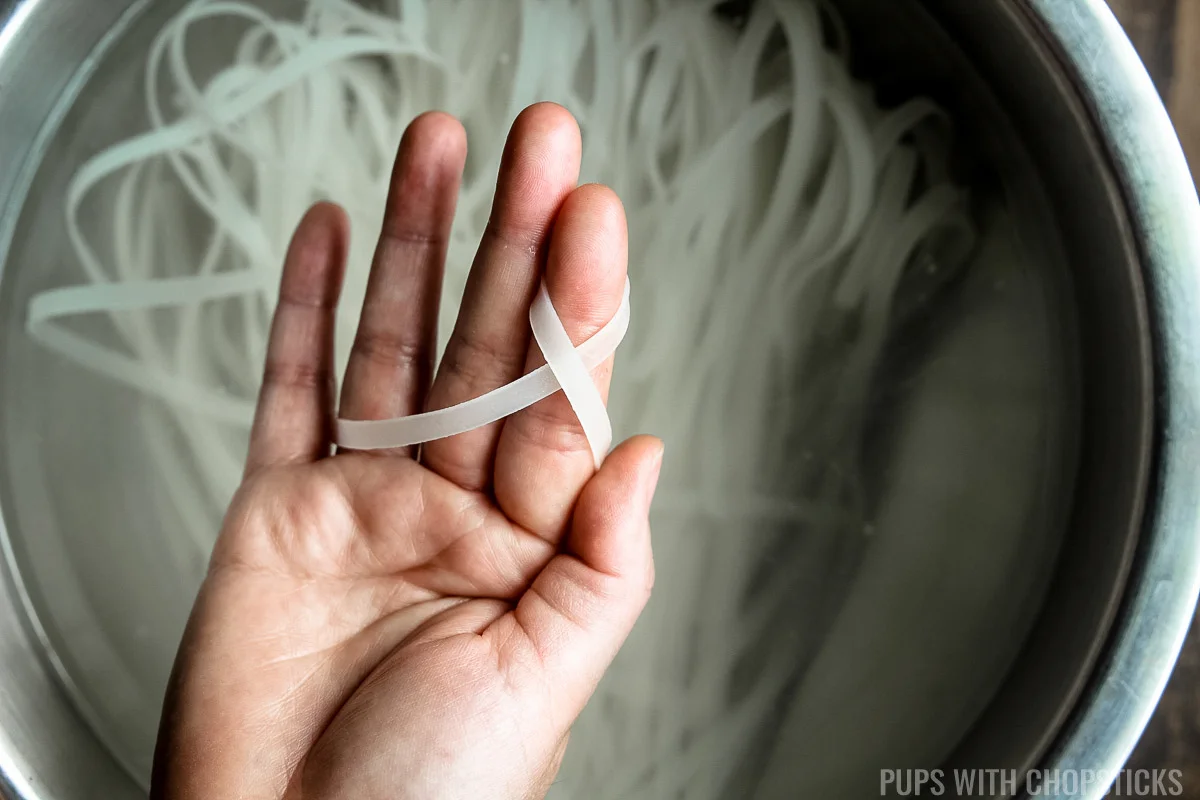
Prepare the Pad Thai Sauce
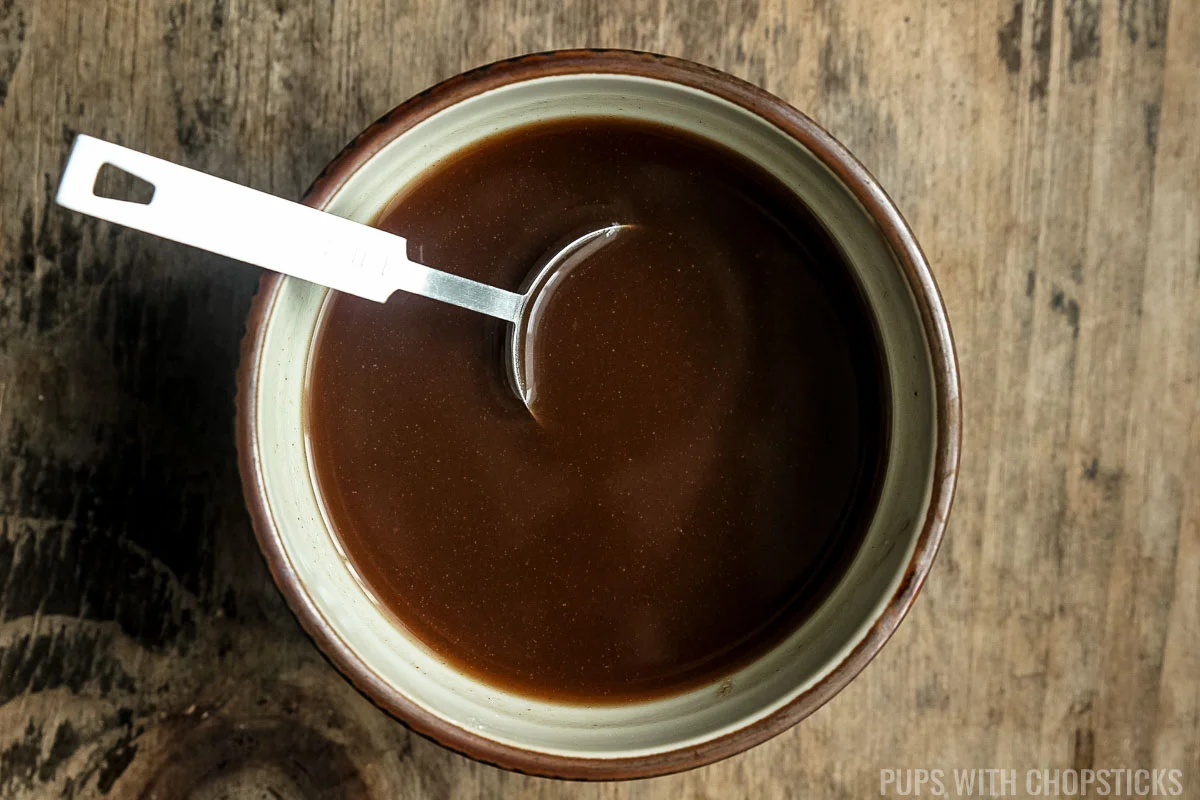
To make the sauce, start by combining all the ingredients in a mixing bowl. Start with the tamarind paste, fish sauce, and palm sugar. Mix them well to create a smooth and even consistency, then add water to thin out the sauce.
If you like your pad thai to be spicy, you can add a tablespoon of sriracha.
If you prefer a more sour dish, use less sugar or add squirt more lime juice right before you eat it. The beauty of this recipe is that it provides you with the flexibility to make adjustments according to your taste buds.
Prepare the Herbs, Aromatics and Veggies
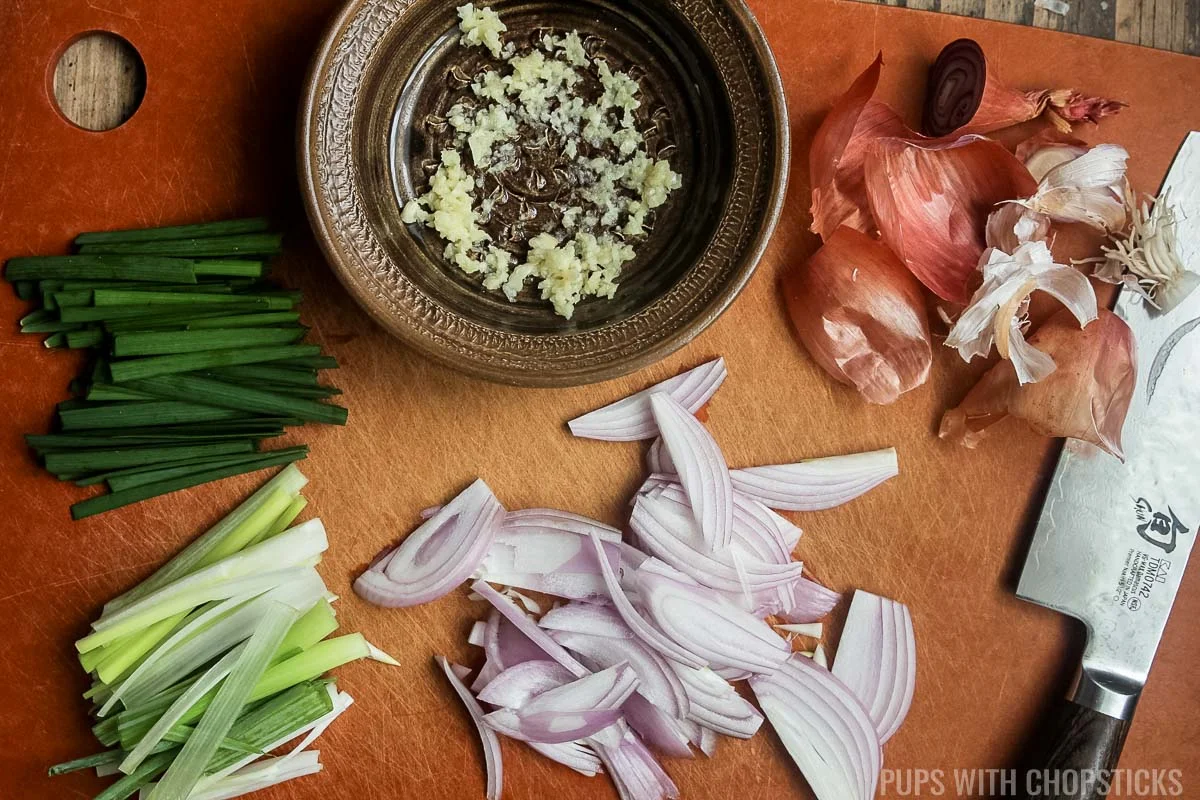
First, peel the garlic and chop it into small pieces. Then, peel the shallots and slice them thinly. Set them both aside for later.
Cut the green onions and garlic chives (if you are using any), into 2 inch pieces. Cut the white parts of the green onion in half lengthwise as well.
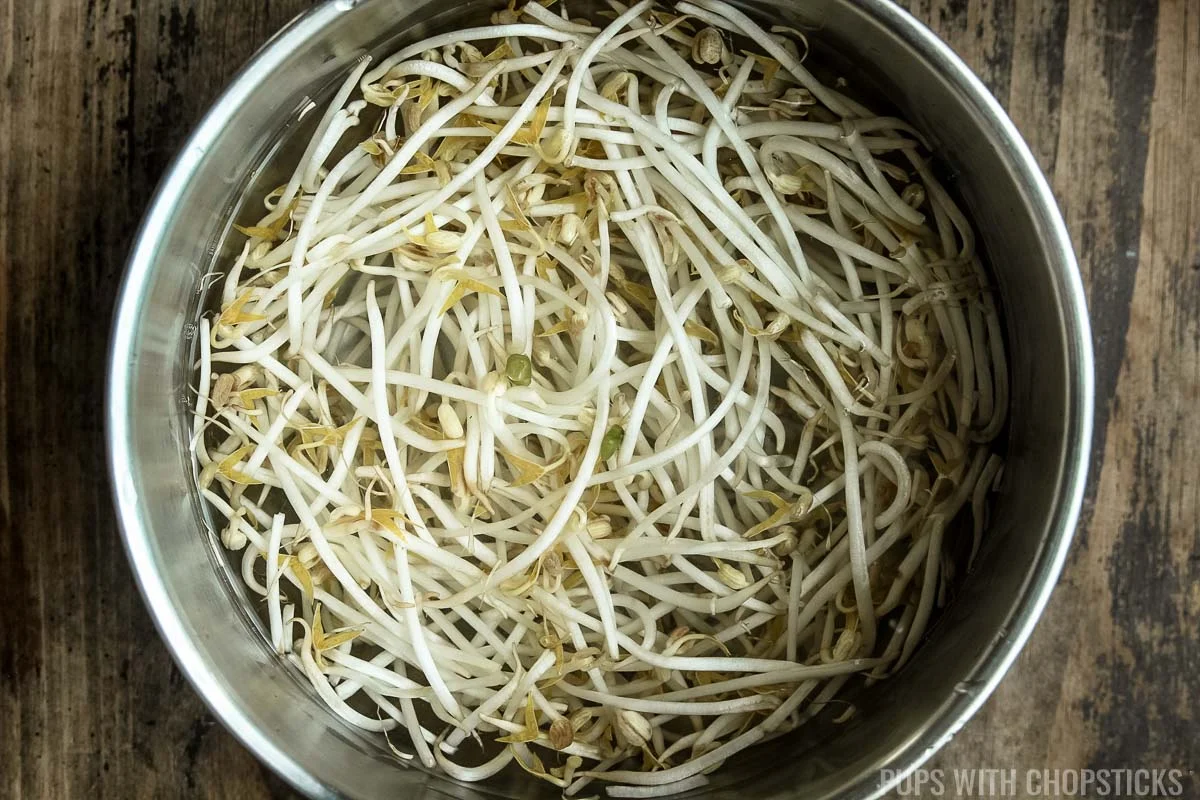
In a large bowl add cold water and the bean sprouts and rinse it until the water runs clear. Remove any soggy brown bean sprouts and discard them.
Stir Fry Everything Together
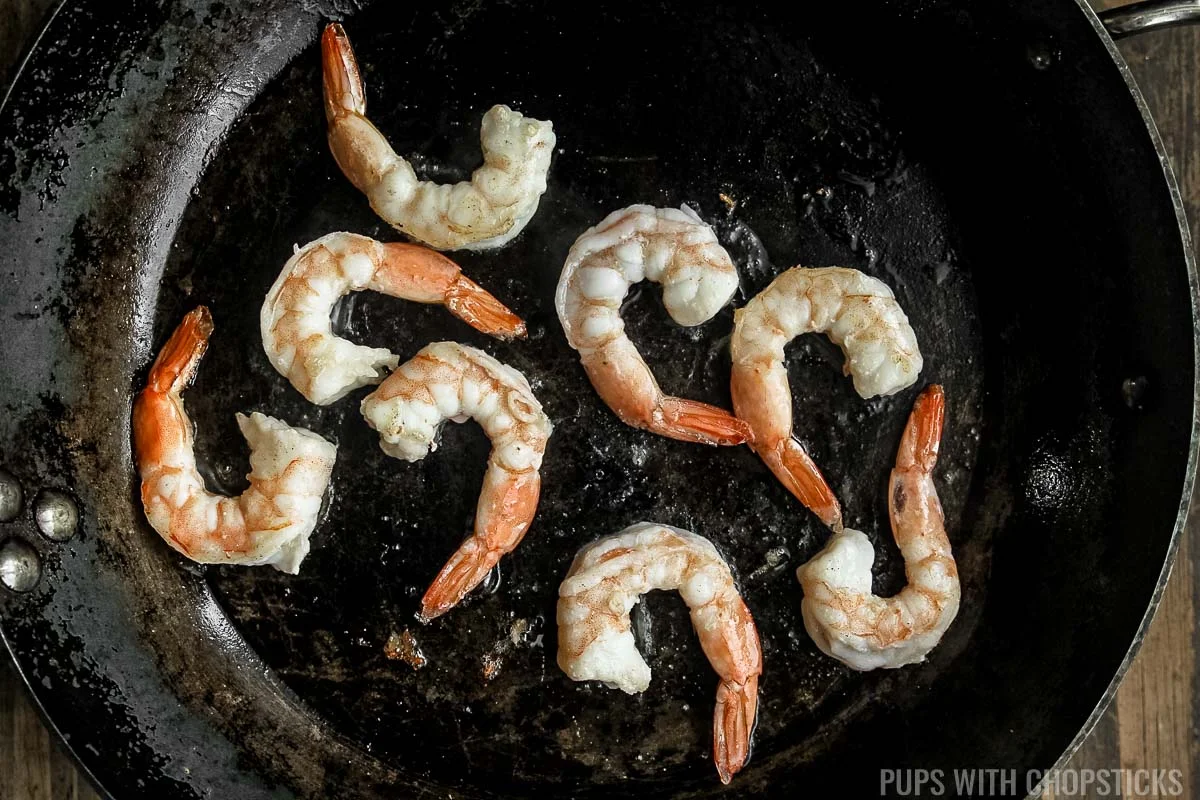
Heat a non-stick pan or wok over medium-high heat and add oil. Once the pan is hot, add proteins like chicken, shrimp, or tofu in and stir-fry them until the protein is cooked through. Remove it from the pan and set it aside.
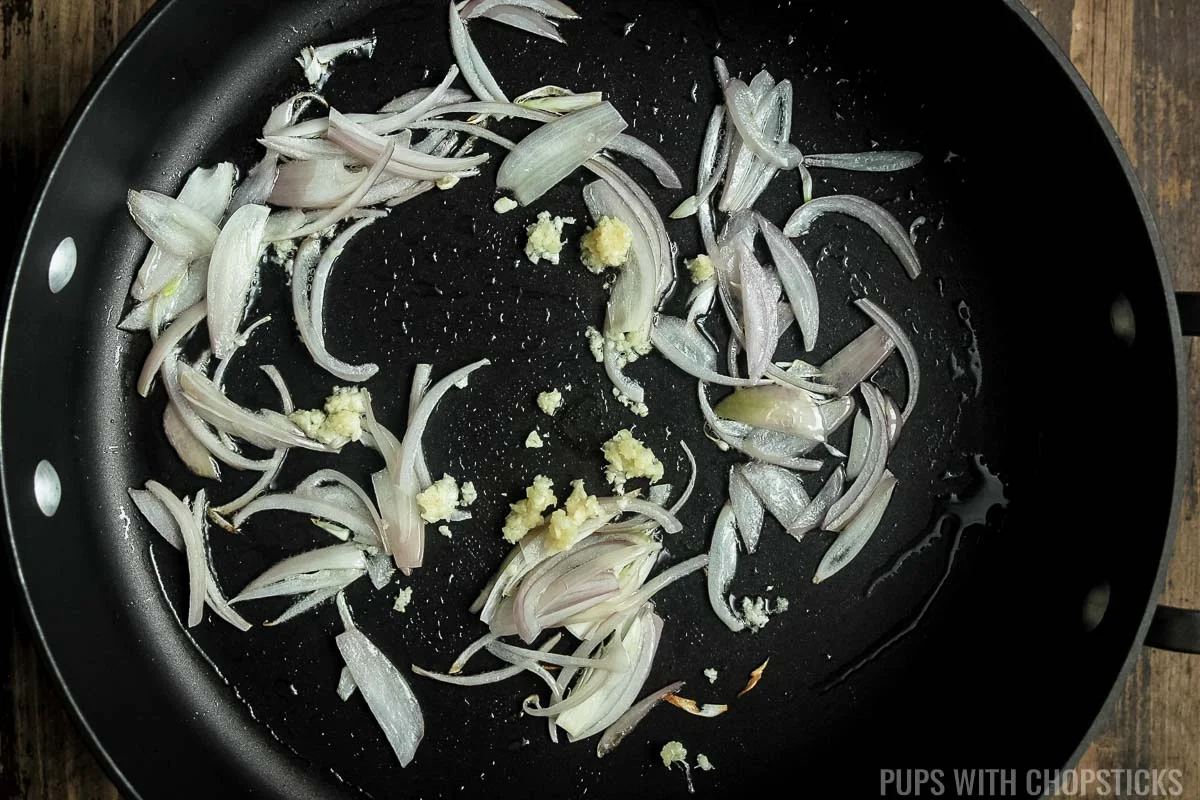
Add a bit more oil into the pan. Once the pan is hot, add in the shallots and stir fry it until they are soft, then add in the minced garlic and stir them together for a few seconds.
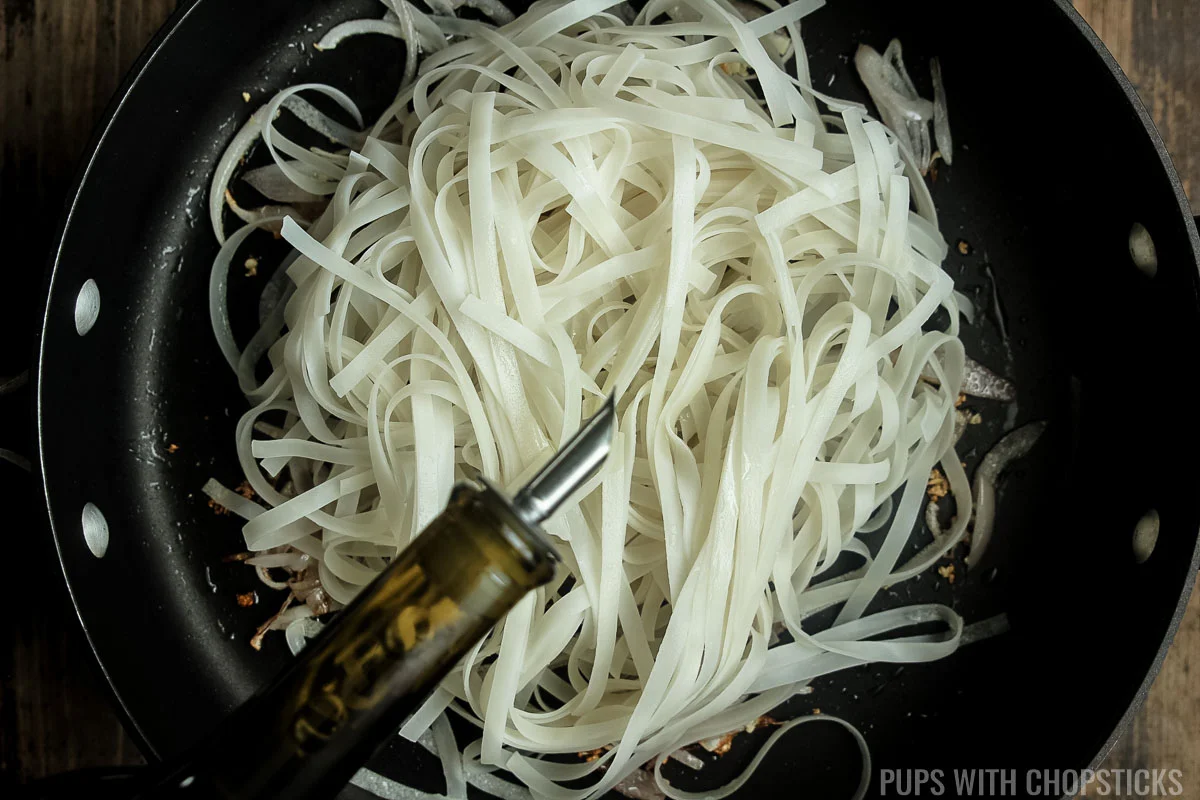
Add the noodles into the pan and drizzle a bit of oil over it and flip it around.
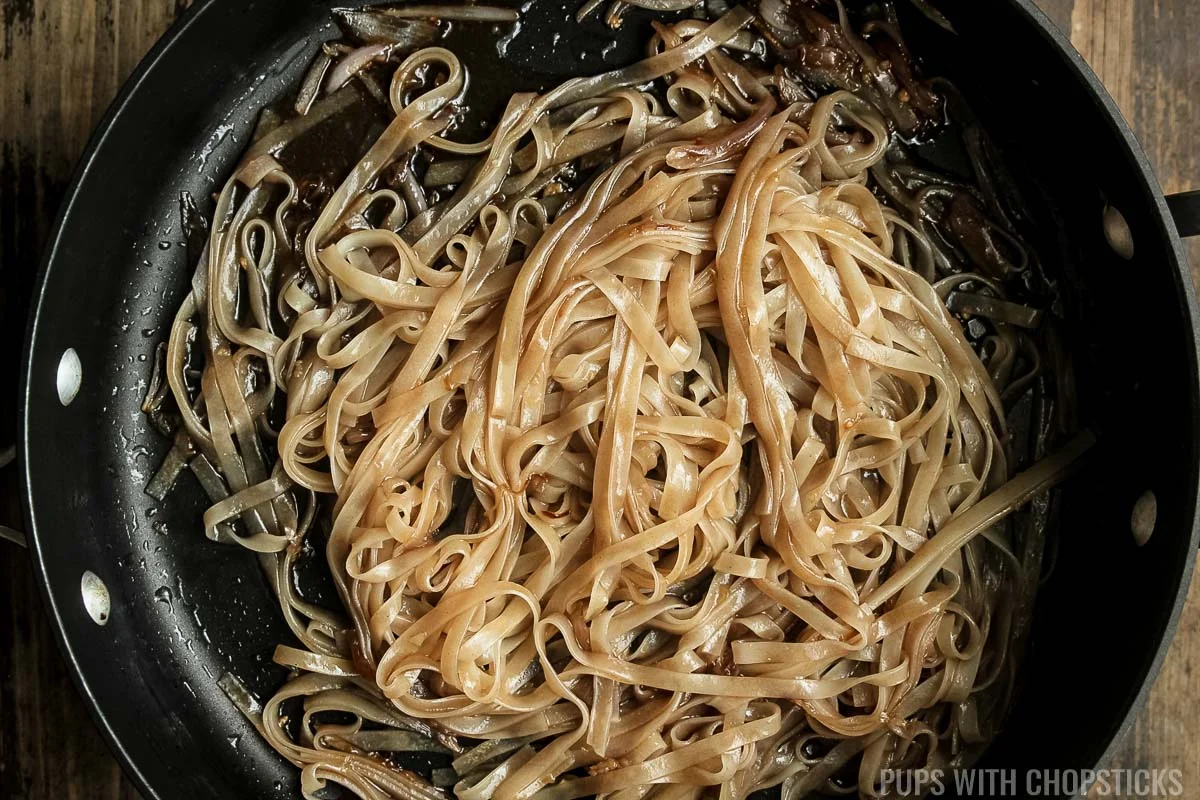
Pour the pad thai sauce over the noodles, making sure to coat each strand evenly. Continue to stir-fry the noodles for a few minutes until they absorb the sauce. If the noodles are too dry, add a few more tablespoons of water.
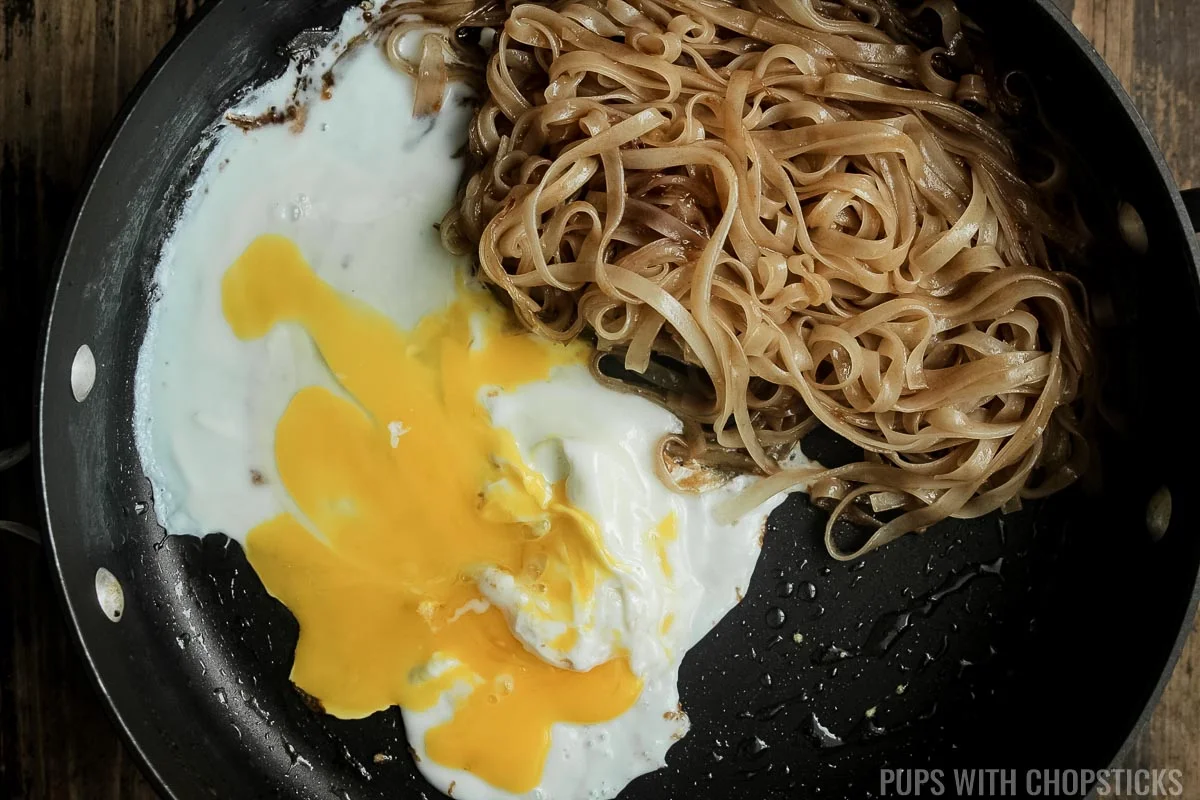
Now it's time to add the eggs to the pan.
Move the noodles to one side of the pan. Add a bit more oil to the pan, and crack the eggs into the pan on the other side. Break the yolks and gently move them around and let the eggs cook until set, then scramble them into the noodles.
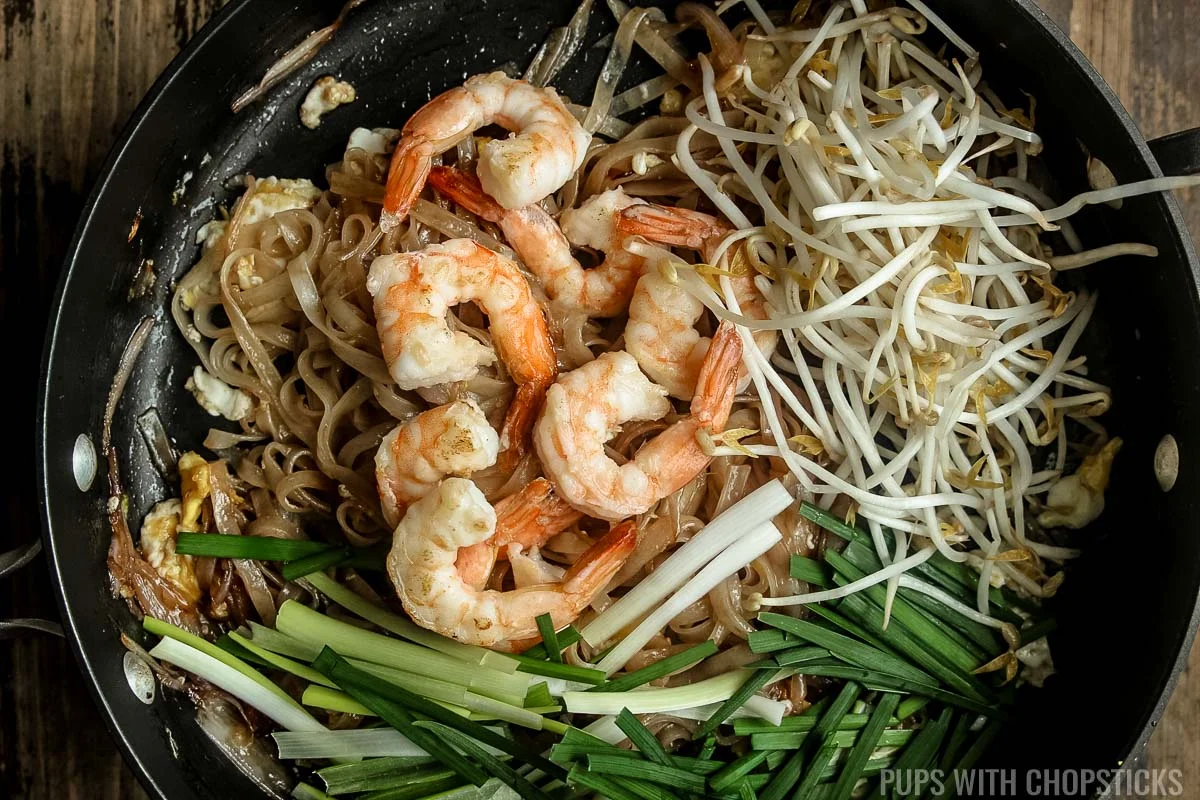
Turn off the heat, and add the bean sprouts and scallions/garlic chives to the pan. Toss them with the noodles and scrambled eggs, allowing the residual heat to soften them slightly.
Place it on a serving dish and sprinkle some toasted peanuts on top and serve it with a wedge of lime!
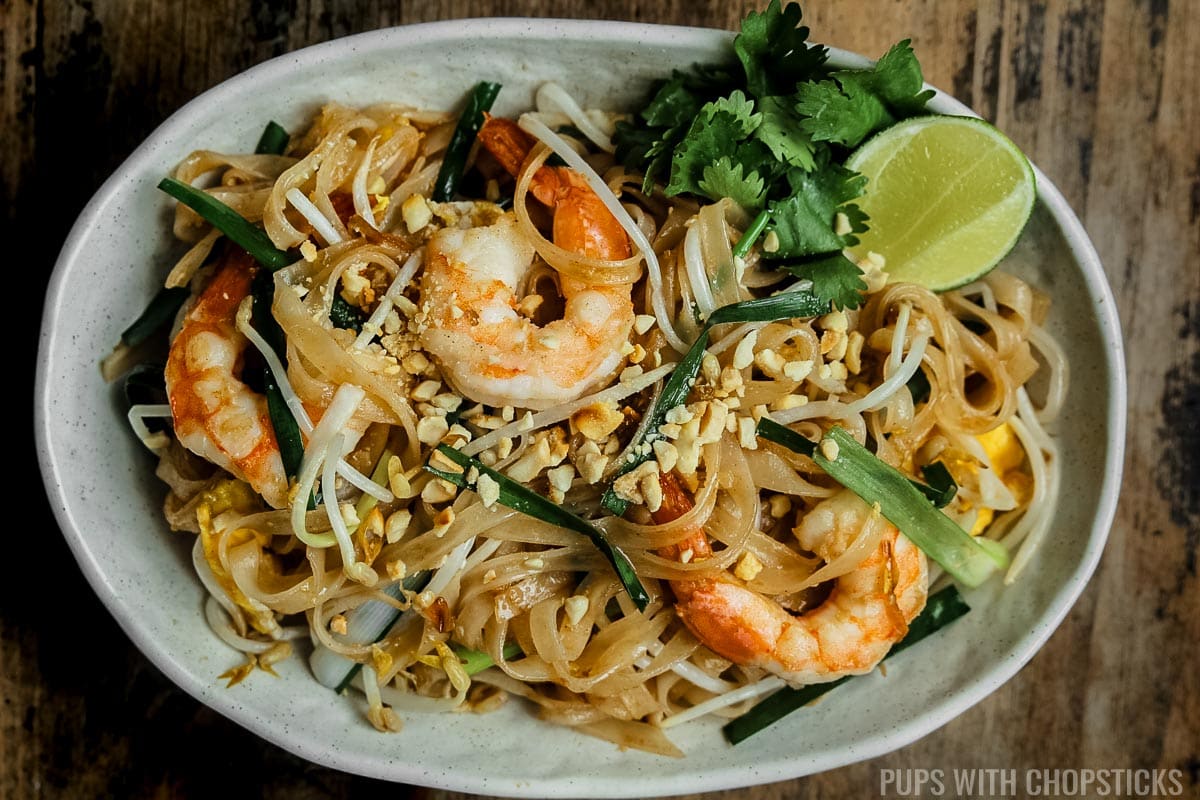
How to Serve Pad Thai
I like to serve this on its own as a meal or have it with a sour Thai soup like Tom Yum or Tom Kha Gai. If I'm serving this to a group of people I also like pairing it up with my most asked for dish, Grilled Thai Coconut Chicken Skewers or Thai Chicken Satay with a side of Peanut Satay Sauce.
How to Store and Re-heat Pad Thai
You can keep in an air tight container, or on a plate covered in plastic wrap for 1-2 days in the refrigerator.
To warm it up, microwave it in 20 second intervals and occasionally loosening the noodles and flipping it with a utensil to avoid hot spots, until it is warm.
Once it is hot, I like to also mix in an additional ¼ cup of fresh bean sprouts to refresh the dish and squirt fresh lime juice on it again.
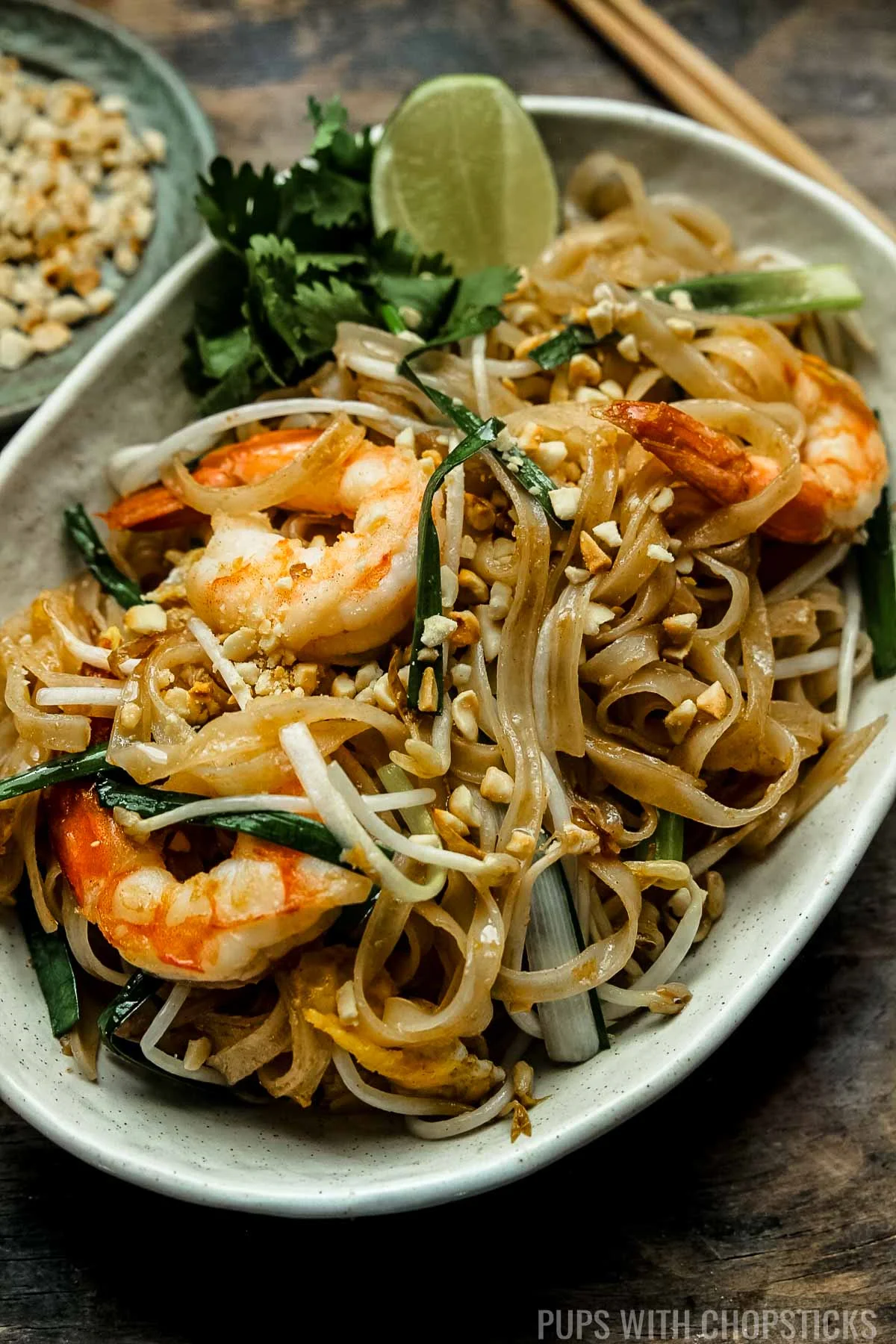
Frequently Asked Questions
Pad thai is known for it's sweet, sour and salty balance of flavors with thinner rice noodles which is stir-fried with scrambled eggs and bean sprouts. Drunken noodles (Pad Kee Mao) is spicy and uses thicker width noodles which are stir fried in a more savory sauce tossed with a lot of aromatic Thai basil.
Pad thai tastes best when freshly made but you can prepare all your ingredients ahead of time (making the sauce, soaking the noodles, and preparing the aromatics) and store everything in the refrigerator, so that when you are ready to make it, it would only take about 5 minutes to put together.
Recipes To Use Leftover Tamarind
More Thai Recipes You May Like
- Thai Basil Chicken (Pad Kra Pao)
- Chicken Khao Soi Recipe (Thai Coconut Curry Noodle Soup)
- Authentic Thai Tom Yum Soup (Classic Tom Yum Goong)
- Grilled Thai Coconut Chicken Skewers
- Yum Woon Sen (Thai Glass Noodle Salad)
- Easy Thai Peanut Satay Sauce
- Pad Woon Sen (Thai Glass Noodle Stir Fry)
- Easy Tom Kha Gai Soup (Thai Coconut Chicken Soup)
Did You Make This Pad Thai Recipe?
If you made this pad thai recipe, I want to see! Follow Pups with Chopsticks on Instagram, snap a photo, and tag and hashtag it with @pupswithchopsticks and #pupswithchopsticks. I love to know what you are making!
Stay connected and follow along on Facebook, Pinterest, and Instagram for all of my latest recipes!
Recipe Card
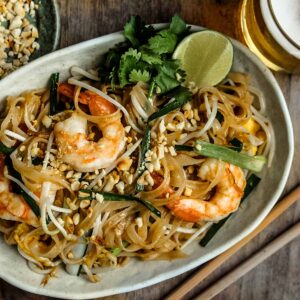
Easy Authentic Pad Thai
Joyce's Recipe Notes
- If you cannot find tamarind concentrate, you can make your own tamarind concentrate by soaking ⅓ cup of tamarind pulp (break it up into small pieces first) with ½ cup of boiling water for about 20 minutes. Mash the pulp with the water and strain out the seed pods (making sure to push the pulp through the strainer with a spoon and scrape the bottom of the strainer for the extra pulp.) Measure out and use the tamarind paste as needed for the recipe. (There will be extra)
- To make it more authentic, you can also add finely chopped dried shrimp or salted pickles for a more salty flavor, but you will need to use less fish sauce so that it's not overly salty.
- If you want to make it spicy, you can add 2 tablespoons of sriracha to the sauce
- Don't Overcrowd Your Pan - When you overcrowd your pan, the sauce doesn't get distributed evenly, and the noodles don't cook evenly as well. You will also need space to push aside the noodles before you add the scrambled egg to the pan. Use a large frying pan, but if you have a small one, split everything in half and do it twice.
- Never Par-Boil Your Noodles - The best part about pad thai is the chewy, flavorful noodles. You never want to par-boil your noodles because it will make them mushy when you stir fry them because you are essentially cooking them twice. For the chewiest pad thai noodles, you only need to soak the rice noodle sticks.
- Don't Use Boiling Water to Soak Your Rice Noodles - Rice noodles are very quick to cook and delicate, and soaking them in boiling water will overcook it. I like to use hot tap water instead to insure they don't overcook while they are soaking. To test if the noodles are at the right consistency, do a finger wrap test after it has soaked for about 15 minutes. Wrap a noodle around your finger, if it breaks - you need to soak it longer, if it wraps easily, it's good to go.
- Don't Overcook Your Bean Sprouts - One of the best things about pad thai is that the textures and fresh bean sprouts give the dish a crisp texture and a fresh flavor. Bean sprouts can be easily overcooked (which can also make your noodles waterlogged). Turn off the heat before mixing the bean sprouts in, you only need the residual heat from the noodles to wilt it enough for the best texture.
- Try to Use the Exact Measurement of Noodles and Sauce for the Best Flavor - For the best sauce-to-noodle ratio, it's very important not to use more noodles than this recipe calls for because it will throw off the balance of the amount of sauce the noodles need to absorb to get that strong delicious flavors. If there are more noodles than sauce, there won't be enough liquid for the noodles to absorb, which will make the noodles dry and flavorless.
Ingredients
- 6 oz dried flat rice noodles (¼ inch width)
- 2 large eggs
- 10 shrimp (fully thawed)
- 2 stalks green onion (cut into 2 inch length pieces)
- 1 shallot (or small onion, thinly sliced)
- ¼ cup garlic chives (Optional) cut into 2 inch length pieces (if you are using this, use only 1 green onion stalk)
- 1 cup bean sprouts (add ½ cup more if you like the fresh crisp from the sprouts)
Pad Thai Sauce
- 3 tablespoon fish sauce
- 3½ tablespoons sugar (or light brown sugar or palm sugar)
- 3½ tablespoons tamarind concentrate (or lime juice)
- 1 tablespoon oyster sauce
- ⅓ cup water
- 1 tablespoon oil
Garnish
- 1 tablespoon toasted peanuts (optional) (finely chopped or crushed)
- 2 lime wedges
Instructions
Soak the Rice Noodles
- In a large bowl, soak 6 oz dried flat rice noodles in hot tap water (not boiling water) for 15-18 minutes. Make sure all the noodles are fully submerged under water.This will soften them up and make them pliable, perfect for stir-frying later on. Once the noodles are soft, drain them and set them aside.
- To test if the noodles are at the right consistency, do a finger wrap test. Wrap a noodle around your finger, if it breaks - you need to soak it longer, if it wraps easily it's good to go.
Prepare the Pad Thai Sauce
- In a small bowl, combine 3½ tablespoons sugar, 3 tablespoon fish sauce, 1 tablespoon oyster sauce, 3½ tablespoons tamarind concentrate, ⅓ cup water and mix well. Set it aside for later.
- (Optional) If you like your pad thai to be spicy, you can add a tablespoon of sriracha.
Prepare the Herbs, Aromatics and Veggies
- Peel the garlic and chop it into small pieces. Then, peel the shallots and slice them thinly. Set them both aside for later.
- Cut the green onions and garlic chives (if you are using any), into 2 inch pieces. Cut the white parts of the green onion in half lengthwise as well.
- In a large bowl add cold water and the bean sprouts and rinse it until the water runs clear. Remove any soggy brown bean sprouts and discard them.
- Cut some lime wedges and set it aside for the very end.
- (Optional) If you are using crushed peanuts, toast some peanuts in a small pan on medium- low heat for a few minutes until golden brown. Make sure to watch it and keep it moving every 15 seconds so they don't burn.Once they are toasted, wait for them to cool and crush them in a mortar and pestle or finely chop it with a knife and set it aside for the end.
Stir Fry Everything Together
- Heat a non-stick pan or wok over medium-high heat and add oil. Once the pan is hot, add proteins like chicken, shrimp, or tofu in and stir-fry them until the protein is cooked through. Remove it from the pan and set it aside.
- Add a bit more oil into the pan. Once the pan is hot, add in the shallots and stir fry it until they are soft.Once the shallots are soft, then add in the minced garlic and stir them together for a few seconds.
- Add the noodles into the pan and drizzle a bit of oil over it and flip it around.
- Pour the pad thai sauce over the noodles.
- Continue to stir-fry the noodles for a few minutes until they absorb the sauce, making sure to coat each strand evenly. If the noodles are too dry, add a few more tablespoons of water.
- Now it's time to add the eggs to the pan.Move the noodles to one side of the pan. Add a bit more oil to the pan, and crack the eggs into the pan on the other side. Break the yolks and gently move them around and let the eggs cook until set, then scramble them into the noodles.
- Turn off the heat, and add the bean sprouts and scallions/garlic chives to the pan. Toss them with the noodles and scrambled eggs, allowing the residual heat to soften them slightly.
- Place it on a serving dish and sprinkle some toasted peanuts on top and serve it with a wedge of lime! Enjoy!
Nutrition
*Nutritional information is calculated using online tools and is an estimate*
Disclaimer: We are a participant in the Amazon Services LLC Associates Program, an affiliate advertising program designed to provide a means for us to earn fees by linking to Amazon.com and affiliated sites. While I appreciate the support – please try to buy your items locally if possible to support your local shops (chances are they are cheaper locally as well!)

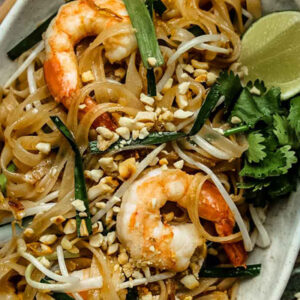
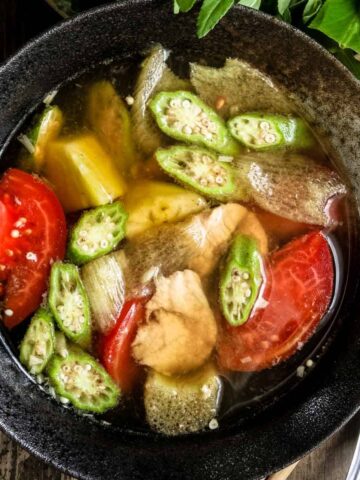
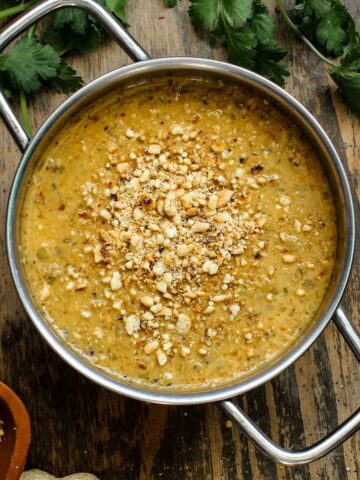
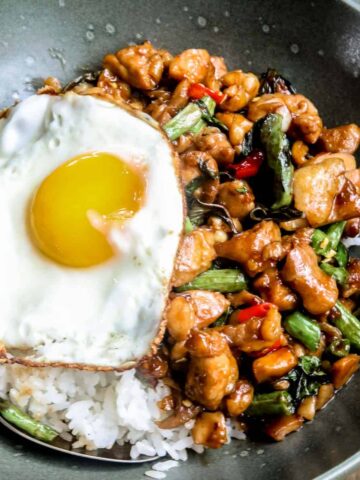
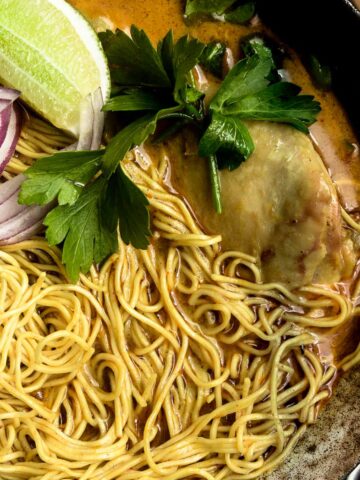
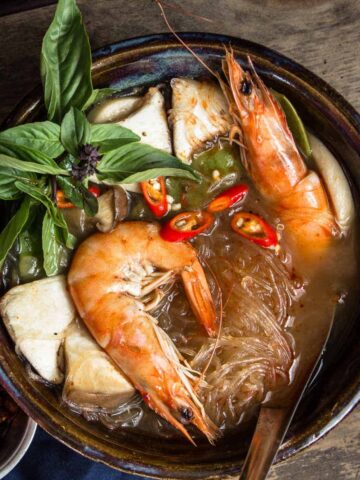
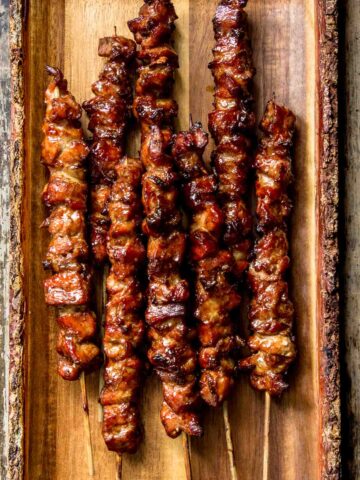
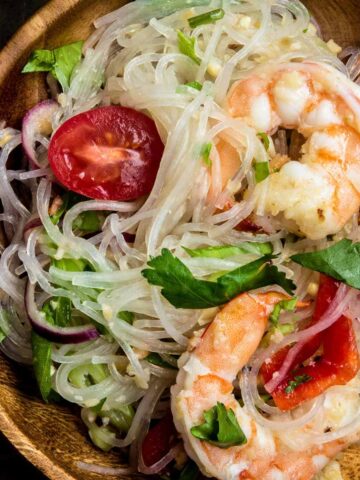
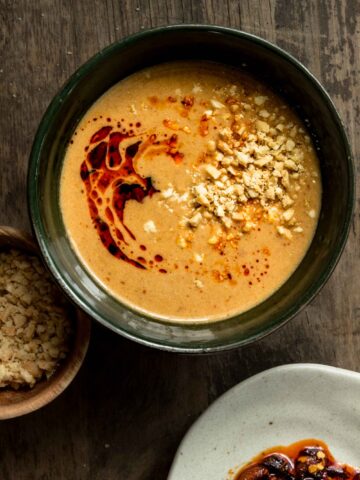
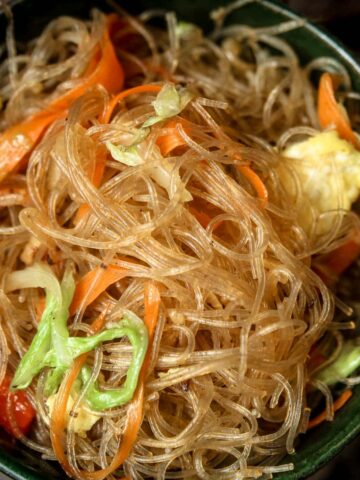
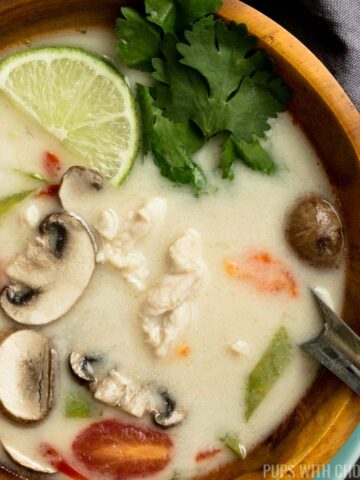
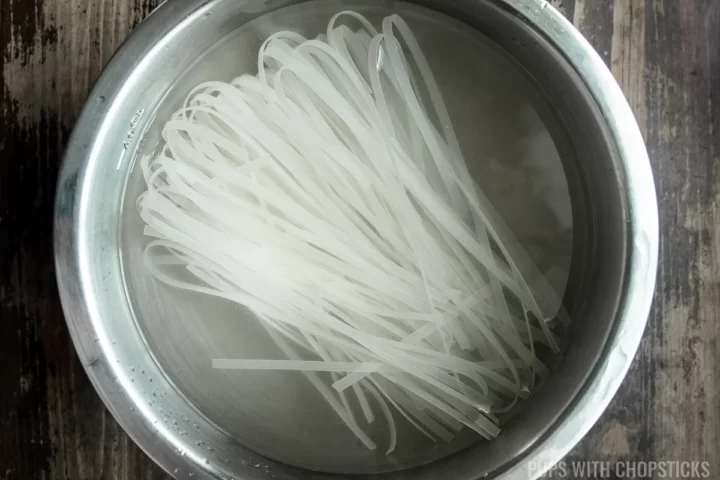
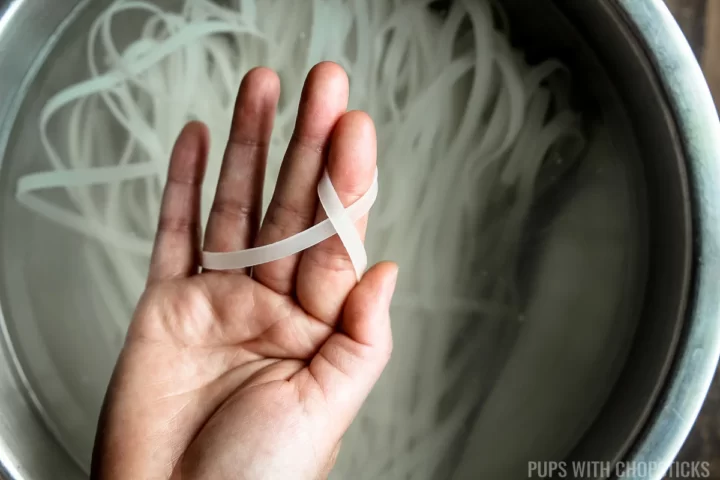
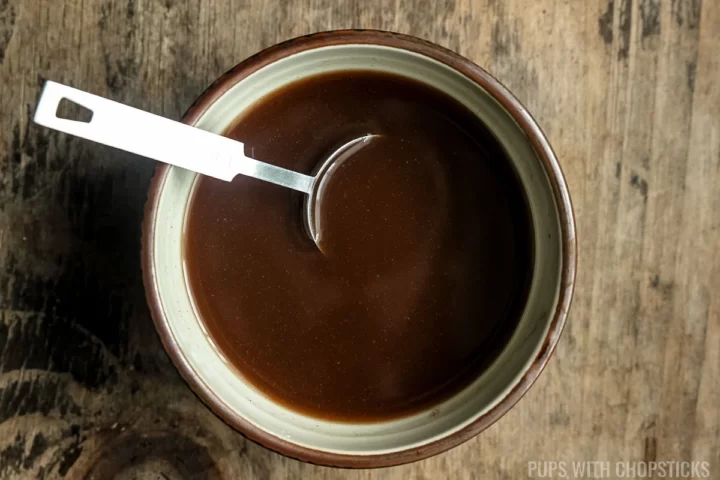
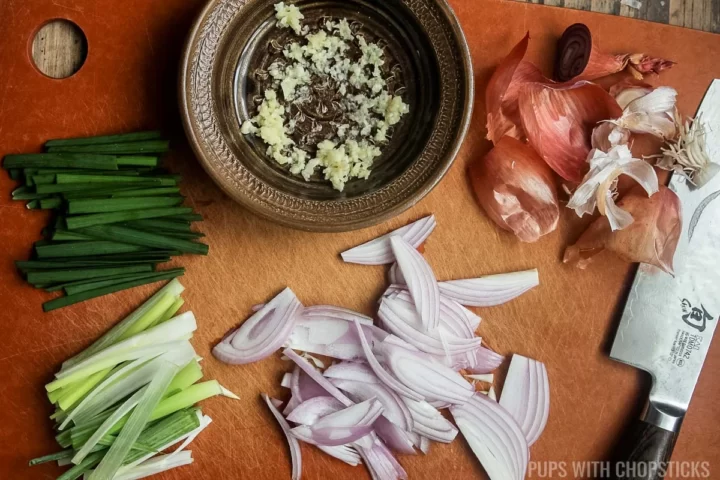
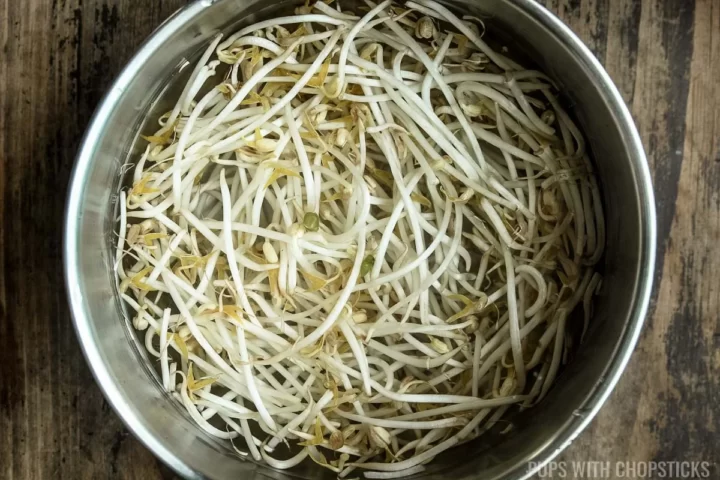
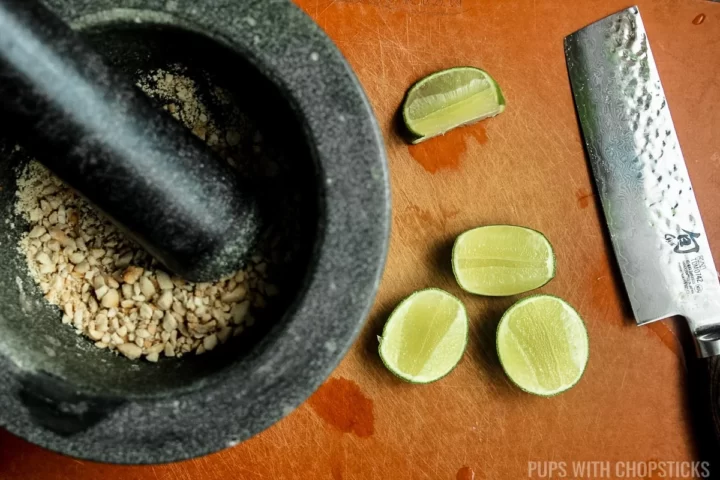
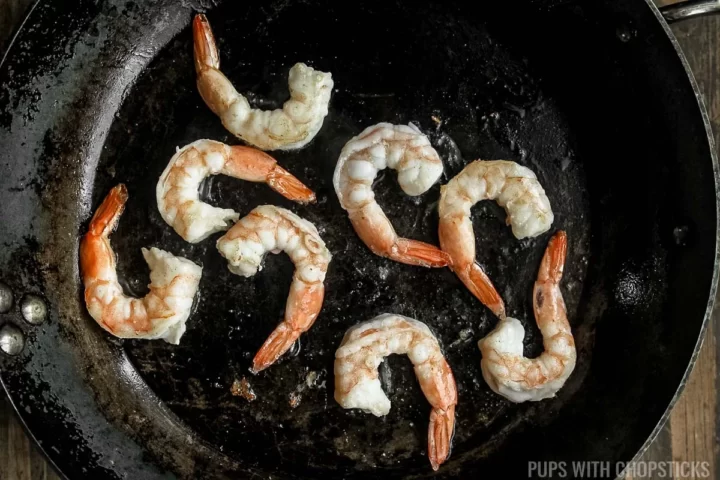
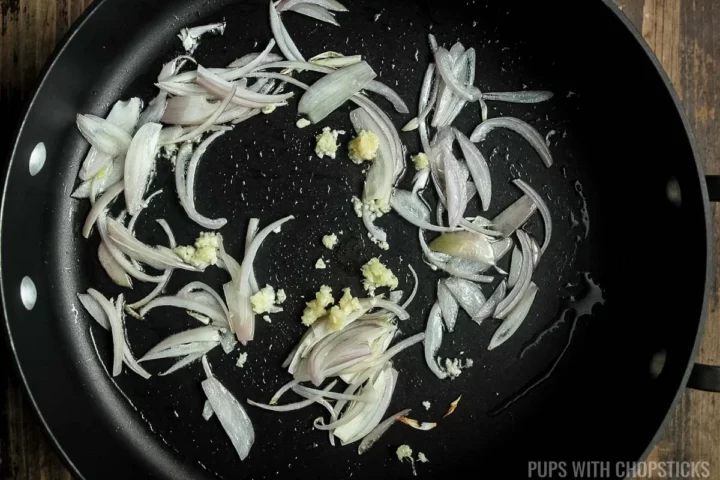
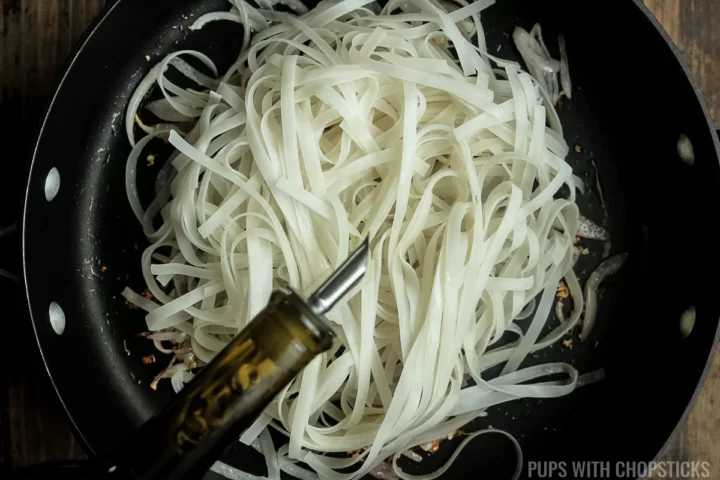
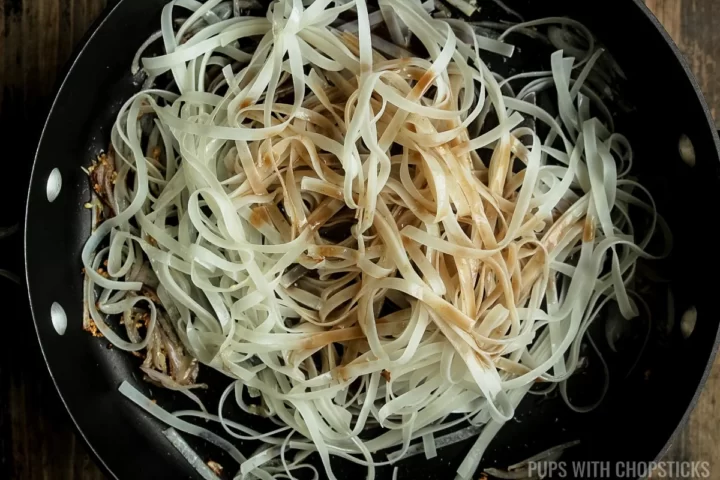
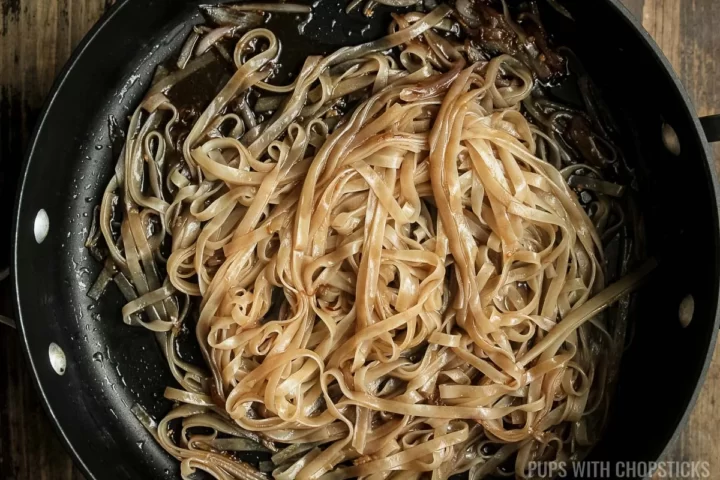
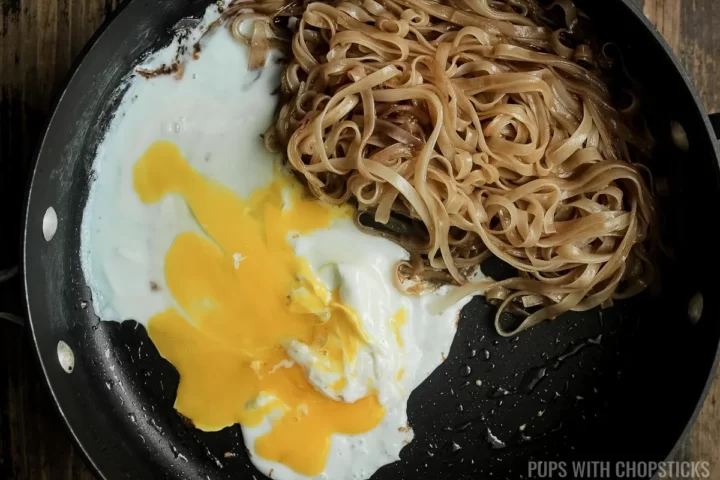
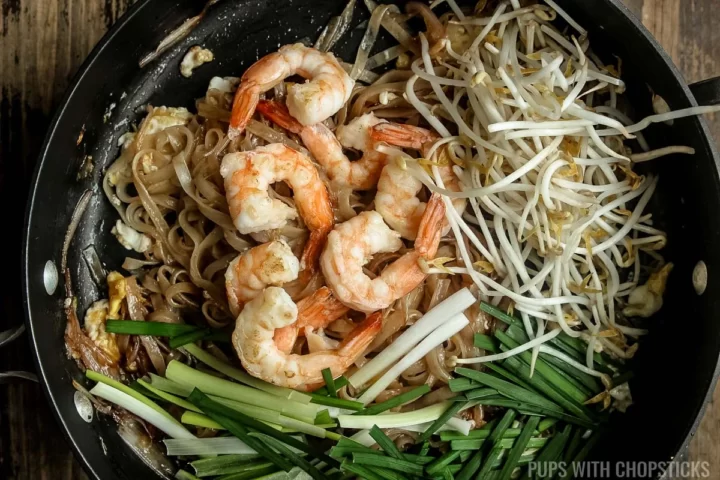
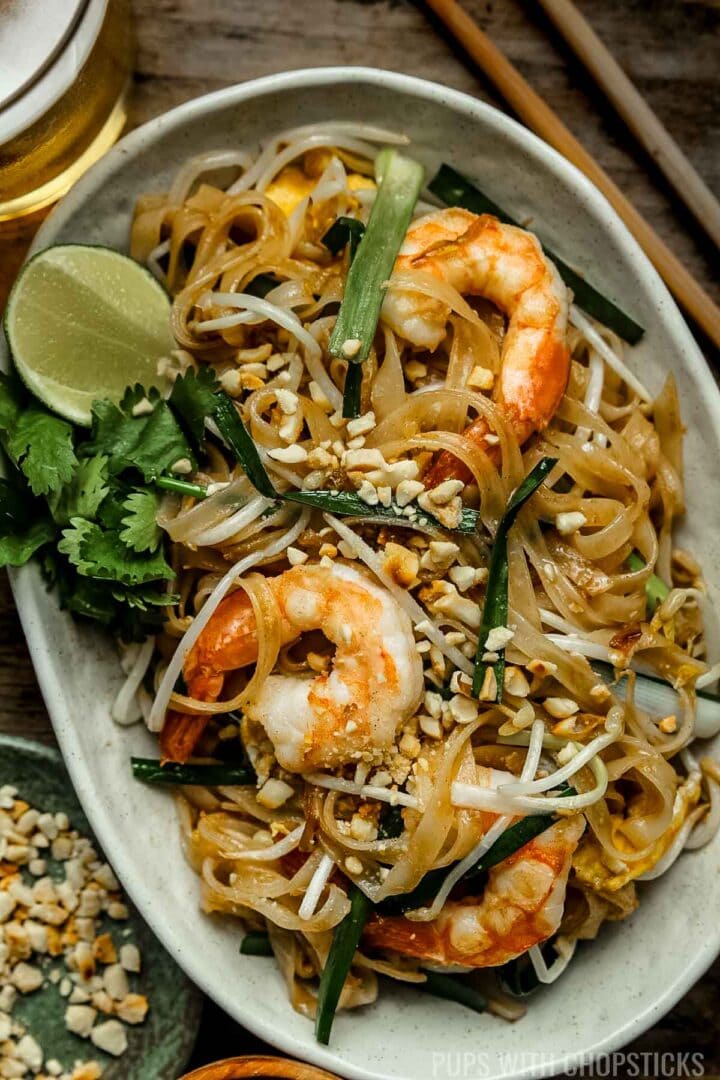
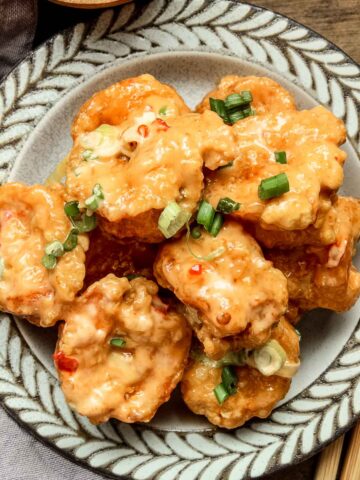
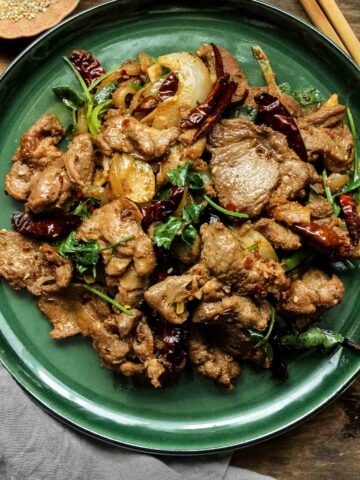
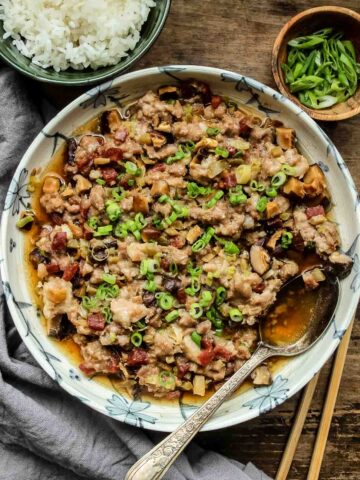
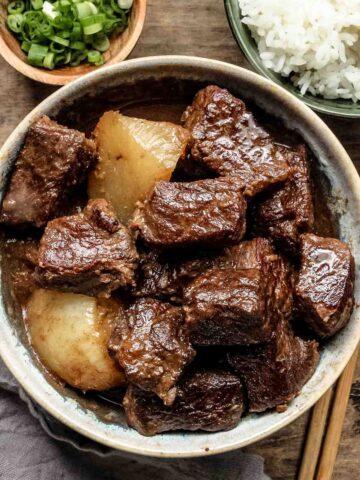
jerome siegel says
I used 10 sheets of paper and most of my ink to print the recipe. That is just wrong.
Joyce Lee says
Hi Jerome,
When you print the recipe card, there is an option to not include 'instruction images' which will only print out the instructions.
Heather H says
Hello!!! I this recipe looks DELICIOUS! And thank you for the clear instructions and visuals. My son has a shrimp allergy; seems ok with other white fish. Salmon may be iffy as well. What fish are used in fish sauce??? I’m going to top the pad Thai with your chicken skewers recipe vs the shrimp, but just wondered if I’m ok to use the fish sauce. He seems ok with oyster sauce. If I can’t use fish sauce, what do you suggest I use in its place?! Thank you!!!!
Joyce Lee says
Hi Heather!
Thank you so much for the kind words! It's always so nice to know that I can be helpful with helping make these recipes at home!
They use anchovies to make fish sauce. I haven't really found a good fish sauce substitute, but I know they have vegan fish sauce. I haven't used it myself, so I can't say if it would be a good substitute though...
But to be safe, I wouldn't risk using fish sauce if he has an allergy to it.
If you had to substitute the fish sauce, I would sub it with soy sauce. Not all soy sauce are the same, some are a lot stronger in flavor so if you can find it, I would use either Lee Kum Kee brand, Pearl River or Kimlan brands (I'm not sponsored to say this, I use these brands at home and genuinely think they are good 😊) I would make sure to use the Light Soy Sauce, or Low Sodium versions of these brands because they don't have an overpowering soy sauce flavor. It won't be an exact flavor but I think the tamarind will help blend all the flavors together which will help.
I hope you enjoy the chicken skewer recipe as well! The Thai coconut chicken skewer is always a hit with everyone every time I make it, and it's quite popular! For that recipe, there is no fish sauce so it should be good to go for your little one.
I hope this helps, and I hope you all enjoy the recipes and have some delicious eats!
scott sproat says
is it an essentional to use tofo in pad thai?
Joyce Lee says
Hi Scott!
No it's not essential to use tofu in pad thai. You can use any protein or no protein to make pad thai if you like! 🙂
Josie says
A very delicious Dish, ingredients are handy to reach from my kitchen. So, I decided to make by your recipe. To my surprise, it turned out really amazingly good, given by my family members to me a 2-thumb up . I would say this compliment should be yours, Joyce.
Thank you.
Joyce Lee says
Hi Josie!
Yay I'm so happy everyone liked it!! Thank you so much for the kind words!
Josie says
You deserved it for your hard work. Please share more of your expertise cooking recipes to us.
Keep rocking ! Thank you.
Susan says
Thanks for the recipe. I never have buy this dish at at restaurants or for take out again. Taste better then some take aways ❤️❤️❤️❤️. Amazing easy to follow recipe
Joyce Lee says
Hi Susan!
Yay! I'm so happy you liked it!! 🥰
Courtenay at The Creek Line House says
This looks so amazing! Thank you for all the detailed photos of every step! So helpful. 😊
Joyce Lee says
Hi Courtnay!
Thank you! Hope this recipe works out for you!